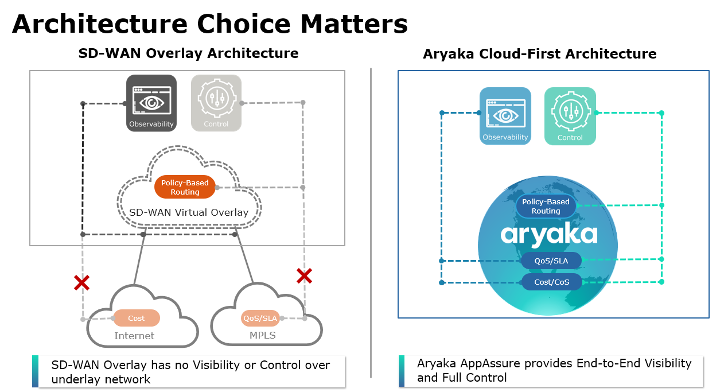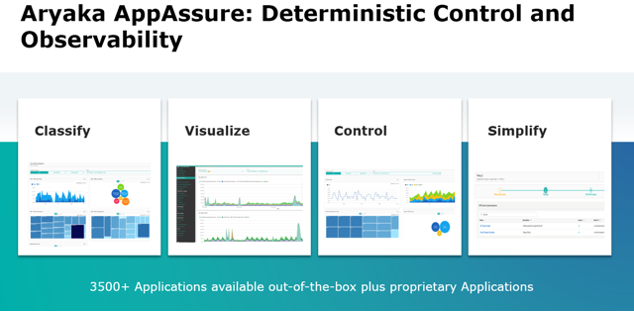Aryaka AppAssure: New frontiers in delivering Application Experience

Role of WAN in delivering App Performance
In my previous blog, I argued that Overlay SD-WAN solutions have failed to deliver on their intended promise of providing a reliable application performance. Overlay SD-WAN’s approach to keep the transportation network at arm’s length fails to ensure application performance. The simple reason is that application performance depends on network performance, and if you treat the network as a black box, you cannot deliver on application performance either.
In this blog, I will explore key features of the WAN solution that solves application performance issues for enterprises.
What does it mean to deliver application performance in the context of the WAN? Simply put, the WAN should not be a bottleneck in delivering the application experience to the users. Users’ application experience should be no different whether an application is distributed across public and private clouds or served from a single server on the LAN.
WAN Characteristics to deliver App Performance
Ability to deliver application performance could be compared to three-legged stool – Robust transport network, Analytics and observability of network and applications end-to-end and ability to remedy. To expand it further, the WAN solution needs some key capabilities to successfully deliver application performance.
Correlation between Network Performance and Application behavior
Application issues are routinely blamed on network and as one of our customers put it, observability and correlation is key to achieve faster “Mean Time To innocence” for IT network teams! The first step in delivering application performance is the ability to measure and monitor and co-relate with network performance. When user is troubleshooting application performance issue, the sooner you identify the issue, the sooner you can resolve it.
Observability:
Every WAN solution claims observability. But typical overlay SD-WAN solution has full visibility at the edge. But once traffic is handed over to underlay network, the visibility disappears. So being able to monitor the application at every segment in the network is the key. Users should be able to monitor applications from a network perspective and monitor the network from an application perspective and how they impact each other. Modern observability techniques that allow users to analyze application traffic in different dimensions; slice and dice it as needed are also very important in comprehending and delivering application performance.
Total control over the transport network:
Once an issue is identified that is causing a poor application performance, remedy often requires granular and total control over every segment of the transport network – first mile, middle mile or last mile.
Per-Application Steering, Optimization and SLA:
Overlay SD-WAN are terrible or almost deceptive in their claim of providing Application SLA. Packing multiple applications in wide moat of Class-of-service and then outsourcing the policy and SLA enforcement to underlay network, does not do anything for Application performance. It is coarse tool that does not yield any benefits in current complex application environment.
With diverging application architecture, WAN should be able to steer individual application to different destinations – remote site or data center within the enterprise network, SaaS or IaaS service, Cloud security provider or simply to direct Internet access.
Various optimization techniques such as WAN acceleration including TCP optimization, SSL and other proxy-based optimization improve application performance significantly. These techniques should be available per-application.
Finally, ability to define per-application SLA and guaranteeing it across multiple segments in the network is needed to ensure superior application performance.
Simplified Workflows:
Monitoring, configuration or troubleshooting workflows should be all integrated in a simple and single tool with closed-loop workflows and instantaneous feedback. Users should be able to manage a global enterprise network and applications from a single pane of glass. As discussed in my previous blog, tool sprawl has become a major concern for enterprise IT teams, so minimizing the number of tools is another hallmark of a successful WAN solution.
Co-management:
An enterprise’s application environment is dynamic. With 100s of applications running in the network, application requirements change constantly. Enterprises cannot depend on Managed Service Provider or Telco to keep up with requests and respond to them rapidly. Enterprise’s need expanded co-management capabilities, allowing them to manage the application environment with confidence. The co-management capabilities need to be intuitive and fool proof, which will give confidence to IT teams and CIOs that application performance is in safe hands with proper tools.
Self-healing networks and application automation:
Beyond basic link or path failover, the network should be able to per-application steer trafic automatically around degraded or failed devices, links, network segments and WAN paths to maintain application delivery and SLA.
Anomaly detection and predictive analytics capabilities within WAN should be able to automate application behavior and optimization.

All this requires the right architecture. The pre-requisite is a Cloud-First WAN with integrated overlay and underlay built from grounds-up. The Cloud-First WAN’s ability to observe and control every segment of network sets it apart from overlay SD-WAN solution. That is why even though it sounds simple, it has been incredibly hard to do for Telcos, DIYs and MSPs with their stitched overlay SD-WAN solutions from multiple technology vendors and network providers. Application Performance at layer-7 demands certain network performance at layer-2 and layer-3. When you have an application-aware network with integrated overlay and underlay, it is possible to understand the application’s needs and fulfill them.
Aryaka AppAssure: Ensuring Application Experience
Aryaka’s Cloud-First WAN architecture with our recently announced FlexCore is perfectly positioned with all the above-mentioned characteristics to deliver on reliable and consistent application performance. Further with the recent launch of AppAssure, Aryaka can deliver unparalleled application experience to its customers. Integrated with Aryaka’s Cloud-First WAN, Aryaka AppAssure delivers application observability and co-management capabilities with simplified workflows to optimize, monitor and ensure application performance. For more information, see our Solution Brief.
As argued in my previous blog, as opposed to Overlay SD-WAN solution, Aryaka’s AppAssure integrated with our Cloud-First WAN, not only solves inflexibility and high cost of MPLS-based solution but also delivers on application experience that an overlay SD-WAN failed to resolve.
In my next blog, I shall deep dive into AppAssure solution to demonstrate how it manages to deliver outstanding Application experience to enterprise users.

Book a Demo
Book a demo with a Aryaka expert to see how Aryaka AppAssure can help your organization to reduce tool sprawl and eliminate swivel chair ops.
Additional Resources
Solution Brief – Aryaka AppAssure: Breakthrough Network and Application Visibility and Control
Blog Part 1 – SD-WAN Overlay – A broken promise of (not) delivering application performance
Datasheet – Aryaka SmartConnect EZ and Pro
- Calypso improved Microsoft SharePoint and Exchange performance by up to 13x
- Bajaj Electricals Enhances VoIP and Web-Conferencing Application Performance
- ThoughtWorks Chooses Aryaka SmartConnect for Faster Application Performance
- Xactly Replaces MPLS, Achieves 6x Faster RDP Performance
- Schenck Process Deploys Unified, Global Network and Solves Global Application Performance Issues
- NVIDIA Experiences 80% Faster Application Performance
- Global Retailer Displaces MPLS to Achieve 20X Faster App Performance
- Enterprise Professional Services company Improves App Performance
- Here’s What No One Tells You About Application Performance
- SD-WAN Solutions for Office 365 Application Performance
- How Latency, Packet Loss, and Distance Kill Application Performance
- How SD-WAN Can Improve Office 365 Application Performance 20x
- SD-WAN Solutions for Office 365 Application Performance
- How to Improve Application Performance for the Remote and Mobile Workforce
- How SD-WAN Can Improve Application Performance for Global Enterprises
- Are SaaS Cloud Applications Slowing You Down?

